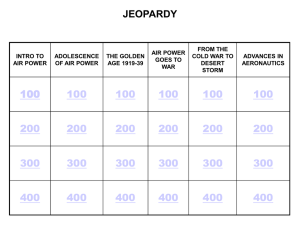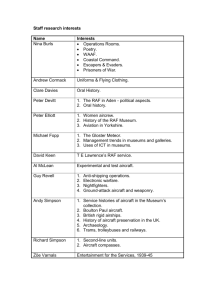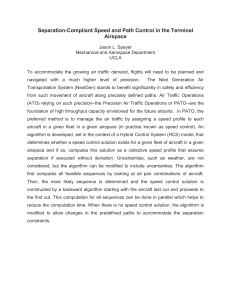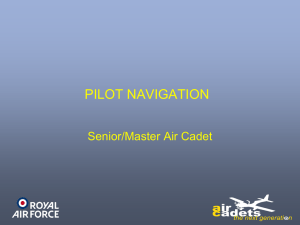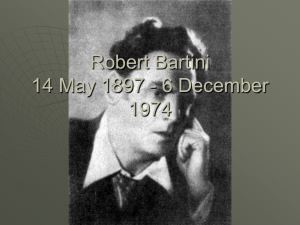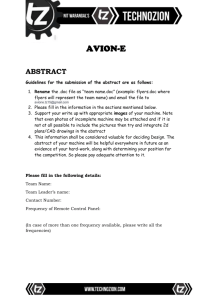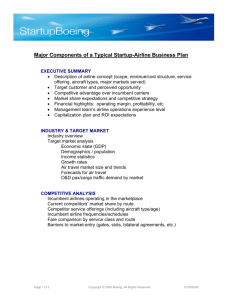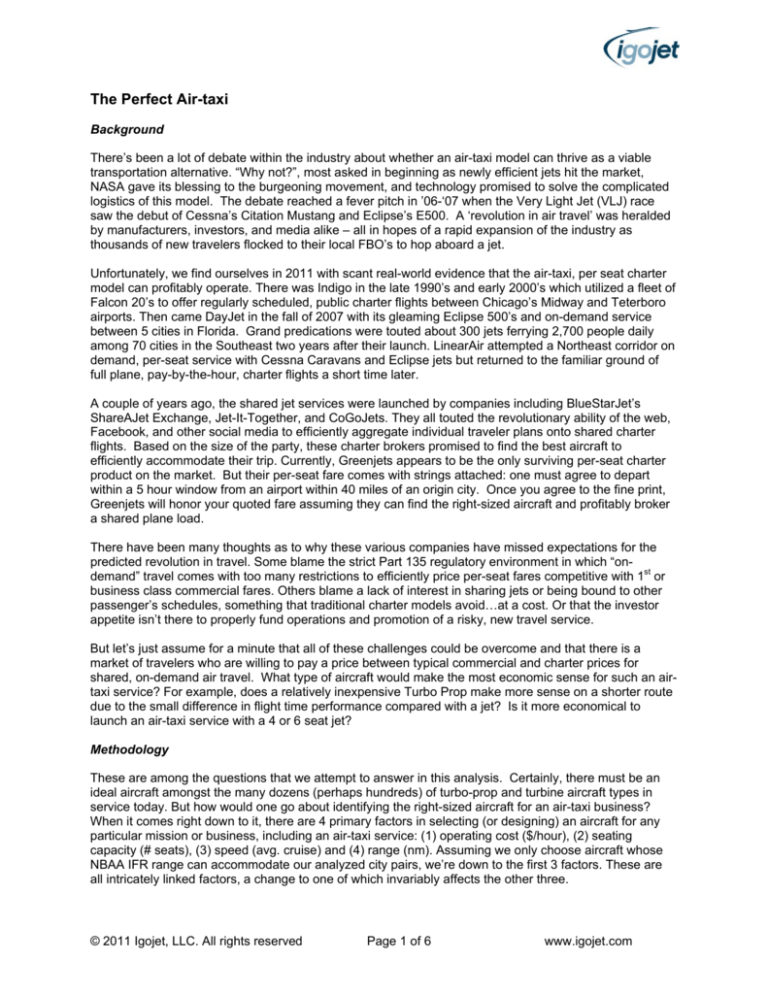
The Perfect Air-taxi
Background
There’s been a lot of debate within the industry about whether an air-taxi model can thrive as a viable
transportation alternative. “Why not?”, most asked in beginning as newly efficient jets hit the market,
NASA gave its blessing to the burgeoning movement, and technology promised to solve the complicated
logistics of this model. The debate reached a fever pitch in ’06-‘07 when the Very Light Jet (VLJ) race
saw the debut of Cessna’s Citation Mustang and Eclipse’s E500. A ‘revolution in air travel’ was heralded
by manufacturers, investors, and media alike – all in hopes of a rapid expansion of the industry as
thousands of new travelers flocked to their local FBO’s to hop aboard a jet.
Unfortunately, we find ourselves in 2011 with scant real-world evidence that the air-taxi, per seat charter
model can profitably operate. There was Indigo in the late 1990’s and early 2000’s which utilized a fleet of
Falcon 20’s to offer regularly scheduled, public charter flights between Chicago’s Midway and Teterboro
airports. Then came DayJet in the fall of 2007 with its gleaming Eclipse 500’s and on-demand service
between 5 cities in Florida. Grand predications were touted about 300 jets ferrying 2,700 people daily
among 70 cities in the Southeast two years after their launch. LinearAir attempted a Northeast corridor on
demand, per-seat service with Cessna Caravans and Eclipse jets but returned to the familiar ground of
full plane, pay-by-the-hour, charter flights a short time later.
A couple of years ago, the shared jet services were launched by companies including BlueStarJet’s
ShareAJet Exchange, Jet-It-Together, and CoGoJets. They all touted the revolutionary ability of the web,
Facebook, and other social media to efficiently aggregate individual traveler plans onto shared charter
flights. Based on the size of the party, these charter brokers promised to find the best aircraft to
efficiently accommodate their trip. Currently, Greenjets appears to be the only surviving per-seat charter
product on the market. But their per-seat fare comes with strings attached: one must agree to depart
within a 5 hour window from an airport within 40 miles of an origin city. Once you agree to the fine print,
Greenjets will honor your quoted fare assuming they can find the right-sized aircraft and profitably broker
a shared plane load.
There have been many thoughts as to why these various companies have missed expectations for the
predicted revolution in travel. Some blame the strict Part 135 regulatory environment in which “ondemand” travel comes with too many restrictions to efficiently price per-seat fares competitive with 1st or
business class commercial fares. Others blame a lack of interest in sharing jets or being bound to other
passenger’s schedules, something that traditional charter models avoid…at a cost. Or that the investor
appetite isn’t there to properly fund operations and promotion of a risky, new travel service.
But let’s just assume for a minute that all of these challenges could be overcome and that there is a
market of travelers who are willing to pay a price between typical commercial and charter prices for
shared, on-demand air travel. What type of aircraft would make the most economic sense for such an airtaxi service? For example, does a relatively inexpensive Turbo Prop make more sense on a shorter route
due to the small difference in flight time performance compared with a jet? Is it more economical to
launch an air-taxi service with a 4 or 6 seat jet?
Methodology
These are among the questions that we attempt to answer in this analysis. Certainly, there must be an
ideal aircraft amongst the many dozens (perhaps hundreds) of turbo-prop and turbine aircraft types in
service today. But how would one go about identifying the right-sized aircraft for an air-taxi business?
When it comes right down to it, there are 4 primary factors in selecting (or designing) an aircraft for any
particular mission or business, including an air-taxi service: (1) operating cost ($/hour), (2) seating
capacity (# seats), (3) speed (avg. cruise) and (4) range (nm). Assuming we only choose aircraft whose
NBAA IFR range can accommodate our analyzed city pairs, we’re down to the first 3 factors. These are
all intricately linked factors, a change to one of which invariably affects the other three.
© 2011 Igojet, LLC. All rights reserved
Page 1 of 6
www.igojet.com
Choosing the right aircraft for air travel alternatives is a familiar exercise by now. Charter companies
generally find the most efficient aircraft that can fly the requested mission within a satisfactory duration
and which can fit the traveling party’s size. Of course, larger or specific aircraft types may be chosen to
accommodate desired creature comforts and personal preferences. Commercial carriers have a more
complicated task in selecting aircraft. Not to simplify this gargantuan effort but they generally must
forecast travel demand during certain scheduled flight times, factoring in connecting flight constraints, and
similarly select the most efficient aircraft whose seating capacity can accommodate peak expected loads.
The task in selecting the right aircraft for scheduled public charter (or scheduled prop service within the
permitted limit of 5 per week) is a roughly similar exercise without the complication of a hub and spoke
system.
But before we go further in discussing the air-taxi planning methodology we used, it’s worth clarifying the
air-taxi model assumed for this analysis. Adhering to the FAA and DOT’s strict definition of “on-demand”
service, we assumed a per-seat service whereby travelers independently select travel itineraries, i.e. the
origin, destination, date & time of travel. However, we permit as part of this itinerary selection the
choosing of either a departure or arrival window of time between 1 and 4 hours in half hour increments.
So, Traveler A may want to specify a tight arrival window between 9AM and 10AM in order to make a
10:30AM appointment while accommodating a busy morning in the home office. While Traveler B
specifies a more flexible return departure window between 5:30PM and 8:30PM since his final meeting of
the day ends at 5PM and he seeks a lower fare return (the larger the chosen window, the lower the fare).
With these basic air-taxi model assumptions (along with others pertaining to specific booking patterns*),
we then repeatedly simulate a single day’s worth of randomly generated reservations to forecast average
costs and statistics for the day’s worth of flight operations. With a statistically significant number of
iterations, we can draw conclusions about the costs of accommodating various volumes of booking
passengers on certain city-pairs with such an air-taxi service.
In order to provide a comprehensive comparison between standard chartered aircraft, we chose the
following 4 types along with these cost and performance metrics:
Aircraft Type
Turbo-Prop [TP]
Entry Level Jet [EJ]
Light Jet [LJ]
Midsize Jet [MJ]
Seating
Capacity
Hourly
Cost
8
4
6
8
$1,200
$1,500
$2,500
$3,500
Average Cruise Speed (knots)
300nm
600nm
900nm
220
240
265
280
235
270
320
325
Examples
1,200nm
250
300
360
375
250
325
380
400
Hawker Beechcraft King Air, Cessna Caravan
Embraer Phenom 100, Cessna Mustang
Hawker 400XP, Embraer Phenom 300, Cessna CJ3
Cessna Citation Excel, Bombardier Learjet 45
Table 1 - Air-taxi Aircraft Types
We then simulated air-taxi service with each of these aircraft types on 4 popular city-pairs for business
aircraft: Van Nuys, CA (KVNY) <–> Las Vegas, NV (KLAS); Bedford, MA (KBED) <–> Washington, DC
(KIAD); Teterboro, NJ (KTEB) <–> Chicago, IL (KPWK); and Teterboro, NJ (KTEB) <–> Fort Lauderdale,
FL (KFLL). Given the above average cruise speeds, the chart below lists the assumed flight times
between each city pair for each aircraft:
Aircraft Type
Flight Time Performance (hh:mm)
Route
Distance
Turbo-Prop [TP]
Entry Level Jet [EJ]
Light Jet [LJ]
Midsize Jet [MJ]
VNY-LAS
BED-IAD
TEB-PWK
199nm
352nm
627nm
TEB-FLL
940nm
229sm
405sm
721sm
1,081sm
0:54
0:49
0:45
0:42
1:29
1:18
1:06
1:04
2:30
2:05
1:44
1:40
3:45
2:53
2:28
2:21
Table 2 - Air-taxi Route Flight Times by Aircraft Type
© 2011 Igojet, LLC. All rights reserved
Page 2 of 6
www.igojet.com
Findings
Which route is best?
First, let’s assume that Charter Operator X has an existing fleet of a single type of aircraft and wants to
determine which route makes the most sense to launch an air-taxi service. From our analysis, the
recommendation would be launch on the longest city-pair which their aircraft type can serve. In general,
longer routes are more profitable, require a lower # of booked segments to break-even, and utilize aircraft
more effectively (i.e. higher % of occupied flight hours vs. empty leg flight hours).
However, these higher margins come at a higher risk in that more aircraft capacity is needed to reliably
accommodate all booked single seat itineraries. In other words the investment in lift or flight time costs to
reliably provide service on a particular route will be higher. For example, let’s say Operator X has a fleet
of light jets and concludes that with the right sales and marketing effort, they can attract 20 passenger
segments per day on any of these 4 routes at an average fare of $3/seat mile. Which city-pair will be best
to target their marketing dollars to first? The below example shows how key statistics for these routes
compare:
Aircraft Type: Light Jet (Hawker 400XP, Embraer Phenom 300, Cessna CJ3)
Daily Booked Seat-Segments (Passenger One-Ways): 20
Price (Fare): $3/seat-mile; Cost: $2,500/hour
Daily Statistics
VNY-LAS
Average One-Way Fare
Average Round-Trip Fare
Revenues
Costs
Profit/(Loss)
Profit Margin
# Aircraft Needed
Total Avg. # Flight Hours
Total Avg. # Flight Legs
Average Load Factor
Route/City Pair
BED-IAD
TEB-PWK
TEB-FLL
$690
$1,370
$1,220
$2,430
$2,170
$4,330
$3,250
$6,490
$13,700
$18,800
($5,100)
(37%)
$24,000
$26,600
($2,600)
(11%)
$41,600
$37,800
$3,800
9%
$62,700
$55,800
$6,900
11%
2
7.5 Hrs.
10.1 Legs
1.9 Pax
2
10.7 Hrs.
9.7 Legs
2.0 Pax
3
16.6 Hrs.
9.5 Legs
2.1 Pax
3
22.4 Hrs.
9.1 Legs
2.1 Pax
Table 3 - Light Jet Performance Statistics by Route
One can see that launching service between Teterboro and Fort Lauderdale (longest route analyzed) will
be more profitable (profit margin of 11%) at 20 booked segments per day but will require a higher
investment in lift (3 light jets at an average daily operating cost of $55,800) in order to satisfy demand.
This may seem counterintuitive given that longer routes are more expensive to fly but the simple fact is
that longer routes enable operators to ensure that passengers are physically in their seats for more hours.
On shorter routes, there’s more time spent turning aircraft around and waiting for passengers versus
flying passengers. Therefore, a longer route will be more profitable at a forecasted demand level for airtaxi service as long as an operator has adequate capacity and financial wherewithal to support higher lift
requirements.
Worth using faster aircraft?
On the other hand, let’s say that Operator X is about to purchase/manage aircraft or has several different
aircraft in their fleet from which to choose in launching an air-taxi service. Which aircraft makes the most
sense on a given route? Let’s take a look at the VNY - LAS route and contrast the various aircraft types,
again assuming an expected demand of 20 one-way segments per day:
© 2011 Igojet, LLC. All rights reserved
Page 3 of 6
www.igojet.com
Route/City Pair: Van Nuys, CA (VNY) <-> Las Vegas, NV (LAS); Distance: 199nm (229sm)
Daily Booked Seat-Segments (Passenger One-Ways): 20
Price (Fare): $4/seat-mile; Average One-way Fare: $920; Average Round-Trip Fare: $1,830
Aircraft Types
Entry Level Jet
Light Jet
Daily Statistics
Turbo Prop
Hourly Cost
Seating Capacity
$1,200/Hr.
8
$1,500/Hr.
4
$2,500/Hr.
6
Midsize Jet
$3,500/Hr.
8
Revenues
Costs
Profit/(Loss)
Profit Margin
$18,300
$10,700
$7,600
42%
$18,300
$12,700
$5,600
31%
$18,300
$18,800
($500)
(3%)
$18,300
$25,000
($6,700)
(37%)
# Aircraft Needed
Total Avg. # Flight Hours
Total Avg. # Flight Legs
Average Load Factor
2
8.9 Hrs.
9.9 Legs
1.9 Pax
2
8.5 Hrs.
10.2 Legs
1.9 Pax
2
7.5 Hrs.
10.1 Legs
1.9 Pax
2
7.1 Hrs.
10.1 Legs
2.0 Pax
Table 4 - VNY <-> LAS Route Performance Statistics by Aircraft Type
One can see from the above chart that the efficiency of the turbo-prop ($1,200/hour) on this route
overcomes any advantages the other aircraft have in speed (lower Flight Hours) and seating capacity.
So, assuming Operator X’s passengers accept a flight time of 54 minutes (vs. midsize jet travel time of 42
minutes), Turbo Props are the way to go (Profit Margin = 42%). But let’s say their passengers demand a
jet due to its faster and quieter travel advantages, the Entry Level Jet again beats out its larger jet
brethren at this demand level (Profit Margin = 31% vs. -3% and -37%, respectively) due to its relatively
low operating costs.
However, it does appear that the speedier aircraft do make up some cost ground with fewer hours despite
their higher operating costs. Could it make a difference on a longer route where larger jets have more
significant travel time advantages over turbo-props?
Route/City Pair: Teterboro, NJ (TEB) <-> Fort Lauderdale, FL (FLL); Distance: 940nm (1,081sm)
Daily Booked Seat-Segments (Passenger One-Ways): 20
Price (Fare): $2.50/seat-mile; Average One-way Fare: $2,710; Average Round-Trip Fare: $5,410
Aircraft Types
Entry Level Jet
Light Jet
Daily Statistics
Turbo Prop
Flight Time (hh:mm)
Hourly Cost
Seating Capacity
3:45
$1,200/Hr.
8
2:53
$1,500/Hr.
4
2:28
$2,500/Hr.
6
Midsize Jet
2:21
$3,500/Hr.
8
Revenues
Costs
Profit/(Loss)
Profit Margin
$54,000
$36,000
$18,000
33%
$54,000
$41,200
$12,800
24%
$54,000
$55,800
($1,800)
(3%)
$54,000
$76,800
($22,800)
(42%)
# Aircraft Needed
Total Avg. # Flight Hours
Total Avg. # Flight Legs
Average Load Factor
4
30.0 Hrs.
8.0 Legs
2.4 Pax
4
27.5 Hrs.
9.5 Legs
2.1 Pax
3
22.4 Hrs.
9.1 Legs
2.1 Pax
3
22.1 Hrs.
9.4 Legs
2.1 Pax
Table 5 - TEB <-> FLL Route Performance Statistics by Aircraft Type
Unfortunately, the same results apply even though the fastest jet in our analysis travels this route in
almost 1 ½ fewer hours than a Turbo Prop. There’s not much to be gained by deploying faster aircraft.
Sure, your passengers might enjoy getting to their destinations faster but your bottom-line won’t be
happier.
So, it appears that speed can make up for higher operating costs but to what extent? In other words, if we
could take a 4 seat jet and speed it up without increasing operating costs, how much more profitable
could Operator X be? Put another way, how many more hourly operating costs could a manufacturer
design into the aircraft in order to increase its travel time performance without sacrificing operating
profits? We analyzed a four seat configured jet at various average cruise speeds with these results:
© 2011 Igojet, LLC. All rights reserved
Page 4 of 6
www.igojet.com
Route/City Pair: Teterboro, NJ (TEB) <-> Fort Lauderdale, FL (FLL); Distance: 940nm (1,081sm)
Daily Booked Seat-Segments (Passenger One-Ways): 20
Hourly Cost: $1,500/Hour; Avg. Price (Fare): $2.00/seat-mile; Seating Capacity: 4 Passengers
Average Cruise Speeds (knots)
Daily Statistics
325
350
375
400
425
Flight Time (hh:mm)
2:53
2:41
2:30
2:21
2:12
Revenues
Costs
Profit/(Loss)
Profit Margin
$43,300
$41,200
$2,100
5%
$43,300
$36,800
$6,500
15%
$43,300
$35,100
$8,200
19%
$43,300
$34,100
$9,200
21%
$43,300
$32,900
$10,400
24%
# Aircraft Needed
Total Avg. # Flight Hours
Total Avg. # Flight Legs
Average Load Factor
4
27.5 Hrs.
9.5 Legs
2.1 Pax
3
24.5 Hrs.
9.2 Legs
2.1 Pax
3
23.4 Hrs.
9.4 Legs
2.1 Pax
3
22.7 Hrs.
9.7 Legs
2.0 Pax
3
21.9 Hrs.
9.9 Legs
2.0 Pax
Table 6 - TEB <-> FLL Route Performance Statistics for 4 Seat Jet by Cruise Speed
While our 4 seat jet can generate 5% margin at its baseline average cruise speed of 325 knots, there are
economic advantages to building a faster jet. An operator can utilize less aircraft at fewer overall hours
while being able to satisfy the same demand. Keeping operating costs constant, the profit margin
increases from 5% to 24% at an average trip cruise speed of 425 knots, an almost five-fold increase in
profits. Or another conclusion that can be drawn from this data is that if one could build a 4 seat jet that
can travel this route at an average cruise of 425 knots,, one could accommodate an increase in operating
costs of $1,900/hour vs. $1,500/hour and maintain the same 5% average profit.
How much is an extra seat worth?
Another decision Operator X might have is how to select an ideal seating capacity or seating
configuration in order to maximize profits with their air-taxi service. Many assume that a larger aircraft,
whose per-seat operating costs at full capacity are lower, will always make more sense to deploy within
an air-taxi service. In other words, if your Citation Excel boasts a full load (8 passengers) per person
operating cost of $0.93/seat-mile vs. your Phenom 100 full load (4 passengers) cost of $1.00/seat-mile,
you ought to utilize Citation Excels to launch an air-taxi service, right? To get our answer, we contrast
each jet’s economic performance with their standard seating capacity on the Teterboro - Chicago city pair
at a demand level of 20 one-way segments per day.
Route/City Pair: Teterboro, NJ (TEB) <-> Chicago, IL (PWK); Distance: 627nm (721sm)
Daily Booked Seat-Segments (Passenger One-Ways): 20
Avg. Price (Fare): $3.00/seat-mile; Average One-way Fare: $2,170; Average Round-Trip Fare: $4,330
Entry Level Jet
Aircraft Types
Light Jet
Midsize Jet
2:05
$1,500/Hr.
4
1:44
$2,500/Hr.
6
1:40
$3,500/Hr.
8
Revenues
Costs
Profit/(Loss)
Profit Margin
$43,300
$30,600
$12,700
29%
$43,300
$37,800
$5,500
13%
$43,300
$51,000
($7,700)
(18%)
# Aircraft Needed
Total Avg. # Flight Hours
Total Avg. # Flight Legs
Average Load Factor
3
20.5 Hrs.
9.8 Legs
2.0 Pax
2
15.2 Hrs.
8.7 Legs
2.2 Pax
2
14.7 Hrs.
8.8 Legs
2.2 Pax
Daily Statistics
Flight Time (hh:mm)
Hourly Cost
Seating Capacity
Table 7 - TEB <-> PWK Route Performance Statistics by Aircraft Type
If we look at key performance and cost data for each aircraft type, we can see that the higher seating
capacities of the larger aircraft can’t overcome their higher hourly operating costs at this demand level.
© 2011 Igojet, LLC. All rights reserved
Page 5 of 6
www.igojet.com
Despite a slower travel time, the Entry Level jet is the most profitable aircraft type to operate for 20
booked passenger segments per day.
However, it does appear that there may a sweet spot of seating capacity assuming a particular demand
and price point. So, we analyzed various aircraft seating capacities at a light jet speed profile and 20
booked segments per day at $3/seat-mile to determine a sweet spot for the Teterboro – Chicago route.
Here are the results:
Route/City Pair: Teterboro, NJ (TEB) <-> Chicago, IL (PWK); Distance: 627nm (721sm)
Daily Booked Seat-Segments (Passenger One-Ways): 20
Hourly Cost: $2,000/Hour; Avg. Price (Fare): $3.00/seat-mile; Travel Time = 1:44 (hr:mm)
Daily Statistics
Revenues
Costs
Profit/(Loss)
Profit Margin
# Aircraft Needed
Total Avg. # Flight Hours
Total Avg. # Flight Legs
Average Load Factor
Seating Capacity (maximum # passengers)
4 Pax
5 Pax
6 Pax
7 Pax
3 Pax
8 Pax
$43,300
$37,500
$5,800
13%
$43,300
$34,600
$8,700
20%
$43,300
$33,400
$9,900
23%
$43,300
$33,200
$10,100
23%
$43,300
$32,600
$10,700
25%
$43,300
$32,600
$10,700
25%
3
18.7 Hrs.
10.8 Legs
1.9 Pax
3
17.3 Hrs.
10.0 Legs
2.0 Pax
3
16.7 Hrs.
9.6 Legs
2.1 Pax
3
16.6 Hrs.
9.6 Legs
2.1 Pax
3
16.3 Hrs.
9.4 Legs
2.1 Pax
3
16.3 Hrs.
9.4 Legs
2.1 Pax
Table 8 - TEB <-> PWK Route Performance Statistics by Aircraft Seating Capacity
Given this speed profile (average cruise speed = 360 knots and travel time of 1:44 hours) there is an
advantage to increasing capacity up to 5 seats. But relative economic advantages stop after the 5th seat
for 20 daily booked passenger segments. In other words, if configuring a light jet for 5 seats is more
attractive to travelers for space and comfort reasons, an operator won’t sacrifice profits to take away a 6th
seat.
Similarly, designing for 4 seats vs. 3 seats (at this speed profile) will yield a profit margin of 20.1% vs.
13.4%, an almost 50% increase in profits at this demand level. This is well worth designing (or choosing)
an aircraft with additional seating capacity, everything else being equal.
Conclusion
So, is there an ideal air-taxi aircraft? Generally speaking, a lower operating cost aircraft will always
outweigh advantages to be gained in selecting faster or higher seating capacity aircraft. Of the 3 basic
aircraft selection criteria - (1) operating cost ($/hour), (2) seating capacity (# seats), (3) speed (avg.
cruise) – operating cost trumps the other two for any air-taxi strategy given typical performance
characteristics of available business aviation aircraft.
However, utilizing more efficient aircraft for an air-taxi service may not always suit an Operator’s
passengers’ wishes for travel comfort and speed. Luckily, Operators can determine quite accurately
whether certain aircraft choices make relative economic sense for a chosen air-taxi routing strategy. Plus,
one can determine a “sweet spot” choice of aircraft given expected demand level and price point that can
maximize an Operator’s profit.
So, why haven’t we seen a commercially successful air-taxi service? It is certainly not for lack of available
aircraft. The answer to that question better lies in the answer to this question. Is there a market for an
on-demand, per seat charter service priced between premium commercial fares and per-person business
aviation rates (i.e. $2-$3 per seat-mile)?
* For a detailed listing of these assumptions, see appendix.
© 2011 Igojet, LLC. All rights reserved
Page 6 of 6
www.igojet.com

